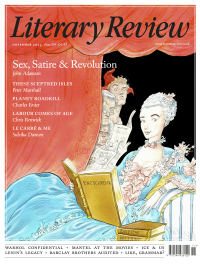Simon Nixon
Brothers Grim
You May Never See Us Again: The Barclay Dynasty – A Story of Survival, Secrecy and Succession
By Jane Martinson
Penguin Business 320pp £25
David and Frederick Barclay were two of the most consequential British business figures of their times. Yet until recently, surprisingly little was known about them, which was exactly how the obsessively secretive and highly litigious twins liked it. That began to change when the family turned their legal guns on themselves. The brothers had fallen out by the time David died in 2021, while later that year Frederick failed to honour a £100-million divorce settlement to Hiroko, his wife of thirty-five years and mother of his only child. Now, in this forensic analysis of their business dealings over seven decades, Jane Martinson has filled in many of the gaps. What emerges is more than just a rags to riches story; it explains much about the state of modern Britain.
From humble beginnings in a two-bedroom flat in Shepherd’s Bush, where they lived with their parents and six siblings, the twins rode the postwar property boom and the financial boom of the 1980s and 1990s to become billionaires, well-connected power brokers and owners of such trophy assets as the Ritz and the Telegraph Group. Margaret Thatcher lived in one of their houses after leaving Downing Street and spent her final months as their guest in the Ritz, while Queen Camilla used to holiday on their yacht. But although for much of their lives they were so close that they dressed the same and finished each other’s sentences, they fell out spectacularly, to the point where David omitted Frederick’s name from a new headstone on their father’s grave.
Yet many details remain murky, not least how the brothers got their first foot in the property market in the 1950s, when Frederick was an undischarged bankrupt. Others active in west London at that time included Michael Heseltine, who made his first fortune renovating a Notting Hill hotel,

Sign Up to our newsletter
Receive free articles, highlights from the archive, news, details of prizes, and much more.@Lit_Review
Follow Literary Review on Twitter
Twitter Feed
It wasn’t until 1825 that Pepys’s diary became available for the first time. How it was eventually decrypted and published is a story of subterfuge and duplicity.
Kate Loveman tells the tale.
Kate Loveman - Publishing Pepys
Kate Loveman: Publishing Pepys
literaryreview.co.uk
Arthur Christopher Benson was a pillar of the Edwardian establishment. He was supremely well connected. As his newly published diaries reveal, he was also riotously indiscreet.
Piers Brendon compares Benson’s journals to others from the 20th century.
Piers Brendon - Land of Dopes & Tories
Piers Brendon: Land of Dopes & Tories - The Benson Diaries: Selections from the Diary of Arthur Christopher Benson by Eamon Duffy & Ronald Hyam (edd)
literaryreview.co.uk
Of the siblings Gwen and Augustus John, it is Augustus who has commanded most attention from collectors and connoisseurs.
Was he really the finer artist, asks Tanya Harrod, or is it time Gwen emerged from her brother’s shadow?
Tanya Harrod - Cut from the Same Canvas
Tanya Harrod: Cut from the Same Canvas - Artists, Siblings, Visionaries: The Lives and Loves of Gwen and Augustus John by Judith Mackrell
literaryreview.co.uk